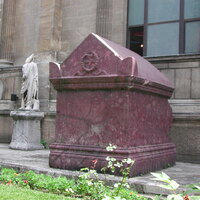Porphyry sarcophagi
Type:
Sarcophagi
Date:
Before the mid-fifth century
Location or Findspot (Modern-Day Country):
Turkey
Medium:
Porphyry
Description:
Porphyry is a very hard reddish-purple stone that contains feldspar crystals in the form of white spots. It was quarried only at Mons Porphyritis (Porphyry Mountain) in Egypt's Eastern Desert, between the Nile River and the Red Sea. Its extraction and dispersal was a monopoly controlled by the Roman emperors, and vast quantities of porphyry were shipped to Rome and around the Mediterranean between the first and fourth centuries CE. The quarries were closed by the fifth century, and all later porphyry sculpture and architectural components—columns, revetment slabs, sculpture—had to be acquired from older pieces, either culled from warehoused stockpiles or stripped from their original context as spolia. Because of its rarity, durability, and imperial associations, porphyry and its purplish color was highly prized throughout the Middle Ages.
Until the mid-fifth century, Byzantine emperors (and usually their wives) were buried in huge porphyry sarcophagi inside Constantinople's Church of the Holy Apostles, which had been founded by Constantine to house his own tomb. Some of these are now displayed outside the Istanbul Archaeological Museum. After the fifth century no more porphyry sarcophagi were available, and the emperors' bodies were housed in marble coffins instead. Porphyry nevertheless retained its imperial mystique. By the tenth century, a Byzantine emperor was said to be porphyrogennetos, "born in the purple," if he was delivered in the Porphyra, a special chamber in the imperial palace. It was described by the princess Anna Komnene (1083–1153), herself a porphyrogenneta, as a square room with a pyramid-shaped roof, the whole interior covered with porphyry. Purple-born princesses were prized commodities in dynastic marriage negotiations between Byzantium and its allies or rivals.
Until the mid-fifth century, Byzantine emperors (and usually their wives) were buried in huge porphyry sarcophagi inside Constantinople's Church of the Holy Apostles, which had been founded by Constantine to house his own tomb. Some of these are now displayed outside the Istanbul Archaeological Museum. After the fifth century no more porphyry sarcophagi were available, and the emperors' bodies were housed in marble coffins instead. Porphyry nevertheless retained its imperial mystique. By the tenth century, a Byzantine emperor was said to be porphyrogennetos, "born in the purple," if he was delivered in the Porphyra, a special chamber in the imperial palace. It was described by the princess Anna Komnene (1083–1153), herself a porphyrogenneta, as a square room with a pyramid-shaped roof, the whole interior covered with porphyry. Purple-born princesses were prized commodities in dynastic marriage negotiations between Byzantium and its allies or rivals.
Relevant Textbook Chapter(s):
2
Image Credits:
Vasileios Marinis


